Green’s the Theme in Extrusion/Compounding
The drive toward circular economy is requiring processors to make more use of PCR. Machine builders at K—across all extrusion processes—will be highlighting innovations to help them do just that.
If you think the “circular economy” is just another feel-good eco-phrase, think again. It’s time to go green. Brand owners and OEMs are pushing recycled-content demands on processors, who are turning to their equipment suppliers for help in processing these challenging materials. If that is what you are looking for, there will be plenty to see, so pack comfy shoes.
Let’s dig in.
Film, Sheet News
Windmoeller & Hoelscher will focus its display on helping film processors make products containing higher levels of PIR/PCR for applications that include barrier structures. Another theme for W&H will be automation and digital systems for improving efficiency, such as its Ruby IoT control system. At K 2019, W&H showed live demonstrations of its Turbostart system for automated stops and startups on blown film lines. At K 2022, the next step will be showing how automated machines can help operators boost productivity; live demonstrations will be run on the Varex II blown film line at the booth.
At K 2022, Reifenhäuser Blown Film will show a fully recyclable pouch with a barrier against oxygen and water vapor suitable for food packaging. The pouch achieves the necessary barrier properties with an EVOH content of less than 5%, allowing it to be recycled with PE streams. Barrier properties are enhanced with the machine builder’s EVO Ultra Stretch stretching.
Reifenhäuser will also display its EVO Fusion technology, which reportedly allows blown film producers to run previously unusable, lowest-quality reclaim into high-performance blown films for simple applications such as trash bags or mailing bags. Until now, these materials could be used only for simple and thick-walled injection molded products. The EVO Fusion process relies on direct extrusion, which saves the energy and cost of repelletizing. The extruder used on the line is a twin-screw, said to homogenize the melt better and ensure a stable process. In addition, processors can degas the system very easily and effectively, removing unwanted components in the reclaim.
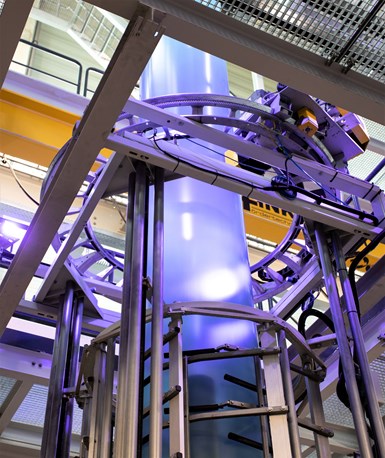
Reifenhäuser’s EVO Fusion technology uses a twin-screw extruder to utilize higher percentages of PCR in blown film. (Photo: Reifenhäuser)
Reifenhäuser Blown Film will also display a new high-performance cooling system for its EVO FFS blown film line, which was developed for heavy-duty sacks. This system increases the cooling capacity by more than 20% compared with conventional systems. In production of heavy-duty sacks, record output rates of more than 600 kg/hr can thus be achieved from a die with 175 mm diam. while maintaining film properties.
On the subject of cooling, Addex will display its Short Stack cooling ring, which is said to boost output by more than 25% vs. the company’s recently designed Intensive Cooling Down-on-the-Die (DoD) system (see July Close-Up).
Bandera will show a nine-layer blown film line producing barrier structures. The line will feature a new control system and user interface for advanced machine operation and data acquisition supporting Industry 4.0. Additionally, the line will be equipped with undisclosed number of what Bandera calls “groundbreaking technical features.” During and after the K show, Bandera will host an open house at its headquarters in Italy. The event will feature running lines, including systems for recycling and upcycling, and a five-layer polyolefin-dedicated (POD) blown film line.
Macchi will have on display an R-POD Flex line, the latest evolution of its POD Flex system, designed for very high productivity and for use of PIR and PCR. The five-layer R-POD Flex line is conceived for sustainable specialty films with reduced thickness and excellent optical, mechanical and sealing properties. This new technology aims to meet growing market demand for highly flexible extrusion lines, capable of extruding recycled materials up to 1200 kg/h at 2500 mm net width. The new R-POD Flex line allows extremely rapid job changes while minimizing scrap. The line on display will show how production can be seamlessly shifted from high-capacity production of lamination films to recycled materials for industrial packaging.
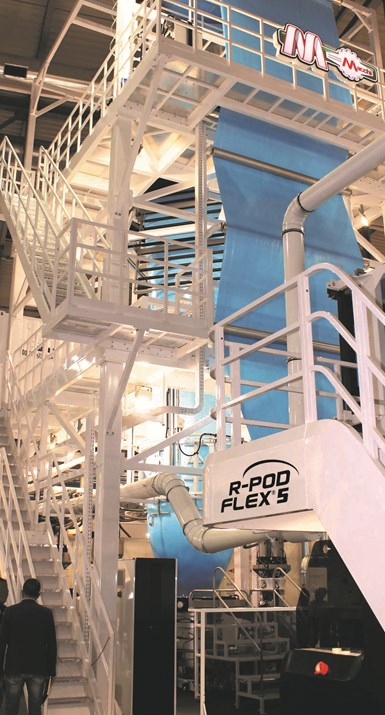
Macchi’s R-POD film line is designed for very high productivity and for use of PIR and PCR. (Photo: Macchi)
The main innovations introduced with this new concept line are:
• New fully automatic and integrated six-component batch gravimetric system with active loading control to reduce time for material changeover and blender cleaning.
• New design and mix of extrusion screws, which allows greater flexibility in processing different materials, together with greater extrusion capacity in 65/80/120/80/65 mm size.
• Continuous screen changer to avoid machine downtime during filter changes.
• New TE556 coex-flex series extrusion head, designed to manage both polyolefin and regenerated film formulations on the same line.
• High-efficiency, fully automatic and integrated high-flow air ring, able to guarantee repeatability while minimizing setup times during job changes.
• Non-contact capacitive film-thickness control system.
• New takeoff unit, series ST426R, with an innovative reduced-height design, securing safer operation and maintenance while enabling a more rapid response to production change commands.
Brückner will focus on its core biaxially oriented film technology, presenting what it says will be new line concepts with significantly higher running speeds for BOPP and BOPET. It will also show a new biax line for nylon (BOPA) that provides up to 80% more output, based on an increase in production speed from 220 m/min to 350 m/min and in line width from 6.6 m to 7.4 m. For battery separator and capacitor films, Brückner will be presenter a wider line (6 m as opposed to its previous 5.5 m limit) to provide a 20% gain in output.
Colines will be showcasing a cast extrusion line that will run daily. The line will be equipped with a number of new but undisclosed features.
Compuplast International will show Version 7.0 of its VEL 3D FEM module, which includes the ability to simulate a multilayer flow field with up to seven different materials on a single mesh. This will allow simulation of coextrusion feedblocks in multilayer flat sheet or film production or multilayer profile dies. For profile dies, the new version can also simulate the deformation of the material just past the die, which can help estimate the final shape of the profile.
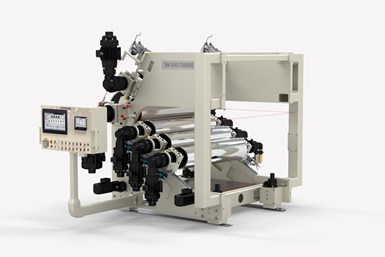
Davis-Standard XP Express AGT roll stand from Davis-Standard is said to provide greater automation and process control for sheet extrusion. (Photo: Davis-Standard)
In sheet news, the XP Express AGT roll stand on display at Davis-Standard is the latest addition to its portfolio. This model is said to provide greater automation and process control. With a space-saving, multi-roll design, processors can take advantage of advanced cooling and polishing, die-to-nip management, web flatness, heat transfer, consistent sheet clarity, and improved performance for low-melt-strength resins.
Pipe, Profile, Tubing News
At K 2022, battenfeld-cincinnati will show the latest in its line of solEX NG extruders for polyolefin pipe. The new solEX NG 45 is the fifth machine in the series, joining its solEX NG 60-, 75-, 90- and 120-mm cousins. Like the larger model, the solEX 45 has an internally grooved barrel combined with a matching screw geometry. This combination is said to ensure extra-high-quality for extruded semi-finished product. When processing HDPE, these extruders also achieve a 25 % higher output, and for PP up to 40% higher output at lower melt temperatures.
Another claimed advantage for the NG series is reduced energy consumption, which is around 15 % lower than the previous solEX series.
The company will also debut some new technology for PVC processors. As battenfeld-cincinnati explains, in PVC processing with counter-rotating twin screw extruders, material flow pulsations are unavoidable, caused by the C-shaped chamber profiles formed by the pair of screws. Especially when producing at lower throughputs—such as with small technical profiles—the fluctuations are more significant. battenfeld-cincinnati has addressed this with the Steady flow control module, which harmonizes these fluctuations and thus ensures a constant material discharge.
With the Steady flow, melt pressure in front of the extrusion die is measured continuously, and the screw speed during each rotation is constantly readjusted. The software includes a learning function, which automatically calculates optimal parameters for compensation of pulsation during the first production run with any new products or new materials. The screw-speed correction parameters identified are saved in the product recipe and remain available for every new production startup. Pressure fluctuations are substantially reduced with the result of a low-pulsation melt flow passing into the forming die. The final results are better semi-finished product quality with fewer dimensional fluctuations and consequently optimal utilization of the material, battenfeld-cincinnati says.
Also for PVC processors, battenfeld-cincinnati will debut a pelletizing extruder series: the aglomEX counter-rotating parallel twin-screw. It’s available in two styles—with or without electrically driven shear-gap adjustment (EMS)—and in 93-, 114- and 135-mm sizes. The aglomEX has 34:1 L/D, offering about 20 % higher output than the previous PVC models. The machines reportedly can handle both dryblend processing and recycling of PCR.
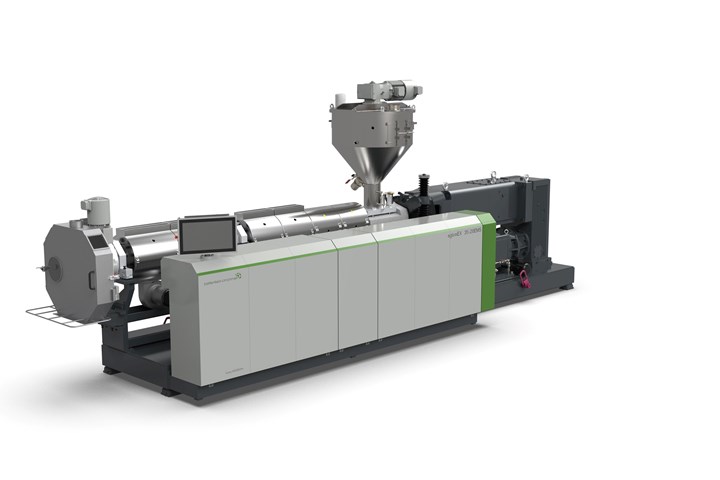
For PVC processors, battenfeld-cincinnati will debut the aglomEX counter-rotating parallel twin-screw extruder for pelletizing. (Photo: battenfeld-cincinnati)
For PVC processors handling an extremely wide and varying range of materials, battenfeld-cincinnati recommends the aglomEX with EMS . The shear-gap adjustment system, powered by an electric motor, is reportedly suitable for processing the entire portfolio of PVC formulations, from soft to hard. The extruders’ special design shapes a shear gap between screw and barrel. This gap can be altered by adjusting the relative position of the barrel to the movable screw to set the requested shear rate. EMS ensures optimal plasticating for a great variety of dryblends and PVC formulations while using the same pair of screws. The advantage for the operator is that time-consuming and costly changeover work is no longer required.
For processing elastomers, Davis-Standard will show the Model 4000A crosshead, which allows for faster startup times and little scrap. The Model 4000A incorporates an automatic, servo-driven concentricity and wall-thickness adjustment system. This new, proprietary, patent-pending system automatically adjusts the core tube/tip assembly to minimize eccentricity, maximize concentricity and reduce downtime during product changeovers. This automated design has a tapered mandrel and highly engineered flow paths to ensure consistent flow through all speed ranges.
In pipe-measurement news, Sikora will debut the Centerwave 6000/1200 for online measurement of wall thickness, inner profile, diameter and ovality over the entire pipe circumference. The new model covers diameter ranges from 250 to 1200 mm. Sikora says it can be easily integrated into a production line, thanks to its slim design, and is particularly suitable for producing pipe diam. of 1000 and 1200 mm.
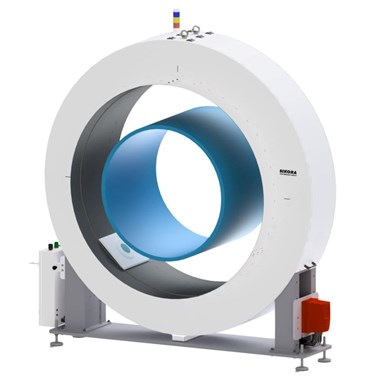
Sikora's new Centerwave 6000/1200 is for online measurement of wall thickness, inner profile, diameter and ovality over the entire pipe circumference. (Photo: Sikora)
All models of the Centerwave series are characterized by their innovative measuring principle based on millimeter wave technology. Operation is intuitive at the push of a button. Once actuated, the operator immediately receives continuous and precisely measured values without presetting the product parameters, without the influence of a coupling medium (water) and without any calibration.
Sikora will also debut its Centerwave 6000/250 for smaller tubes from 50 to 250 mm diam.. It enables 100% measurement of the wall thickness, as well as the determination of diameter and ovality for tubes with wall thicknesses down to 1.5 mm due to its automatic adjustment of the rotation speed. Like all Centerwave devices, the system is equipped with a transceiver that continuously rotates 360° around the product. In doing so, it automatically adjusts the transceiver's rotation speed to the line speed, thus ensuring seamless quality control.
Compounding News
Coperion will be featuring the high-performance ZSK Mc18 extruder with 70-mm screw diameter. With its high specific torque of 18 Nm/cm3, it is especially suited for compounding plastics at very high throughput rates and with low energy consumption. The ZSK extruder is equipped with a ZS-B easy side feeder as well as a ZS-EG side devolatilization unit. Thanks to their simple design, both these units are said to significantly reduce the time needed for recipe changes or maintenance tasks, since they can easily be removed from the process section in just a few steps. A K3-ML-D5-V200 vibratory feeder from Coperion K-Tron will be mounted at the main intake of the ZSK 70 Mc18. The ZS-B easy will be equipped with a K-ML-SFS-BSP-100 Bulk Solids Pump (BSP) feeder.
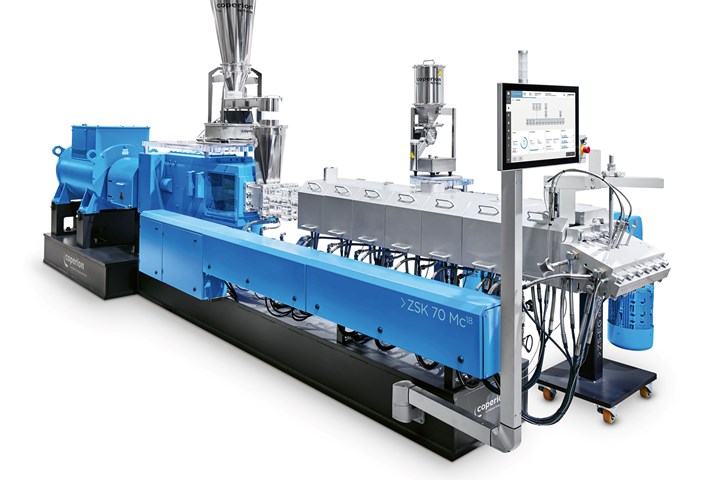
The high specific torque of Coperion's ZSK Mc18 is especially suited for compounding plastics at very high throughput rates and with low energy consumption. (Photo: Coperion)
Another highlight at the Coperion booth will be the STS Mc11 series laboratory extruder with a 25-mm screw diameter. It stands out with its simple design, user friendliness and easy cleaning. Its Do/Di of 1.55 and specific torque (Md/a3) of 11.3 Nm/cm3 allow for safe scale-up across the entire STS Mc11 series. The extruder will be exhibited with a Coperion K-Tron K-ML-SFS-KT20 twin-screw feeder.
Moreover, the new, preconfigured ProRate Plus feeder line from Coperion K-Tron will be displayed in all three available sizes: small, medium, and large. This continuous gravimetric feeder is said to be very robust and an economical solution for reliable feeding of free-flowing bulk materials.
The SP series dual-bearing strand pelletizers have been given a comprehensive facelift; Coperion’s SP340 model will represent this development at K. Compared with the previous model, the new SP strand pelletizer allows even faster recipe and color changes. The cutting chamber works with absolutely no dead space; thanks to its quick-release function, the cutting unit can be swapped out quickly and easily. The pelletizer’s interior has improved accessibility and is very easy to clean.
Coperion will also display its ZXQ 800 rotary valve. This high-performance valve, which works with especially low gas leakage, was developed for powder intake into pneumatic conveying lines at up to 3.5 bar. Thanks to its enormous capacity, it is very well suited for polyolefin manufacturing lines.
On the open-air fairgrounds within the VDMA Circular Economy Forum, Coperion will present its combined process solutions and technologies for economical recycling of various plastics while achieving the highest levels of product quality. At the center will be a system built around a ZSK 58 Mc18 twin-screw extruder configured for manufacturing high-quality PET from recycled materials.
For feeding voluminous flakes and fibers of PET and other plastics efficiently into the ZSK twin-screw, Coperion will show the SWB-300 Smart Weigh Belt Feeder with a S100 single-screw pre-feeder, as well as the new ZS-B 70 Megafeed side feeder. The SWB is a gravimetric feeder that can process large volumes of bulk materials with a wide variety of flow properties at very high accuracy. Using the innovative Coperion ZS-B Megafeed, plastic recyclate with a bulk density under 200 kg/m³--long considered intake-limited and thus not worth recycling—can be reliably fed in large quantities into smaller sizes of Coperion’s ZSK twin-screw extruders.
Melting, intensive devolatilization, and complete homogenization take place in the process section of the ZSK 58 Mc18, before the material stream is transferred via a gear pump and filter with an automatic screen changer to an underwater pelletizer. Finally, PET pellets are condensed in the SSP (Solid State Polycondensation) reactor and can then be processed again into bottles, fibers, or films. The high quality of recycled PET manufactured using this Coperion process was approved by the U.S. FDA for direct food contact (letter of non-objection).
Conventional technologies for recycling PET require pre-drying and crystallization of flakes and fibers before they can be reprocessed. Using Coperion's process solution, PET recyclate can be introduced directly into the ZSK extruder. Recyclers profit particularly from the very high product quality. Thanks to the ZSK’s devolatilization properties, volatile components such as monomers, oligomers and water are reliably removed. If the plastic pellets produced create undesirable odors, these can be reliably removed using deodorization equipment from Coperion.
KraussMaffei will show its ColorAdjust technology on a twin-screw compounding extruder. Shredded medical caps will be compounded into a fiber-reinforced recyclate. The innovative system combines a spectrophotometer and machine control to ensure precise, reproducible colors.
The ColorAdjust solution is said to be the first of its kind on the market. It is designed not only for contactless monitoring of color variations, but to compensate for even minor deviations. This gives compound processors high reproducibility even when processing input materials of varying color. The color setpoint is rapidly achieved when starting the compounding process after a stop, as well as during color changes. Since startup scrap and reject material are thus minimized, ColorAdjust ensures sustainable and highly efficient production of reclaim material. This will save not only time and money, but above all valuable raw materials.
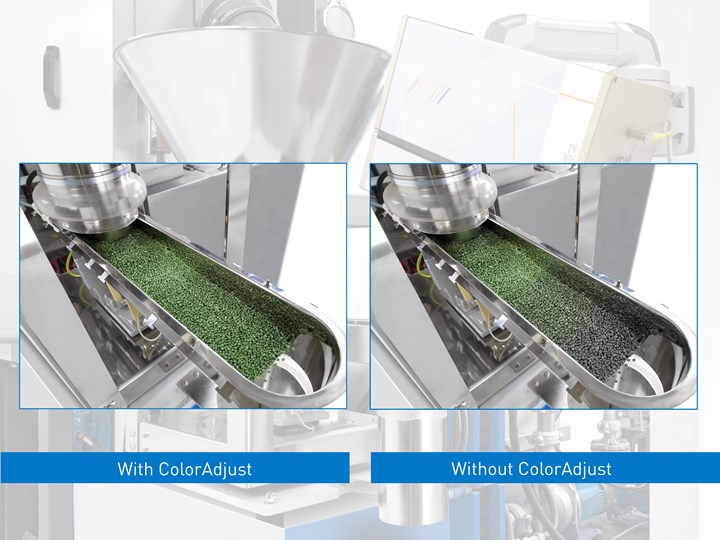
ColorAdjust technology from KraussMaffei controls and adjusts the color-metering unit to compensate for even minor deviations. (Photo: KraussMaffei)
KraussMaffei’s ColorAdjust system is comprised of two units: A spectrophotometer determines the color of the cooled reclaimed pellets in the vibration chute and transmits the corresponding results to the machine control. These values are used to control the color-metering unit, which is equipped with at least four colors and four metering devices. Upon request, the system can be expanded to six colors to flexibly cover the entire color spectrum that the human eye can distinguish. The color can generally be added in masterbatch or liquid form. The ColorAdjust system adjusts the color feeding fully automatically without any operator intervention. Thanks to its integration into the twin-screw extruder control system, it can be operated easily from the central control panel.
At the KraussMaffei booth, visitors can get a live experience of the entire material cycle: from virgin PP right through to the finished reclaimed, recompounded material. A KM PX 200-1400 injection molding machine equipped with a 96-cavity tool will produce insulin pen caps from PP. Downstream, these caps will be subsequently shredded to regrind. The resulting reclaimed material will then be transferred by a conveying system into the ZE 28 BluePower twin-screw extruder in UltraGlide version with a processing section length of 44 D. Thanks to the UltraGlide feature, the screws can be removed automatically from the processing section for cleaning purposes. The extruder’s optimum ratio between screw volume and torque reportedly ensures optimum melt homogenization and color dispersion. Glass fibers and additives, as required for applications in the automotive industry, for instance, can be incorporated via additional gravimetric feeders.
Xaloy will showcase its X-900 bimetallic liner for segmented twin barrels. This new alloy reportedly provides extraordinary durability in high-wear or high-pressure applications in resin manufacturing and compounding. It provides users with a cost-efficient and sustainable alternative to other wear-resistant alloys.
New Extruders, Too
Equipped to save space while offering outputs of at least 20% vs. existing grooved-feed models, Davis-Standard’s SHO 90-mm extruder is engineered with a new gearbox, optimized feed section and high-performance, energy-efficient DSB barrier screw. This is especially beneficial for high-viscosity HDPE applications such as pipe extrusion, where lower melt temperatures, reduced power consumption and improved energy efficiency are paramount.
Davis-Standard’s Maillefer line of new MXD series high-performance extruders also will be on display in 45- and 80-mm sizes. Besides the two extruders will be extrusion heads dedicated to three applications: micro-drip irrigation, blown fiber microducts, and heating/plumbing tubing. Downstream equipment will also be shown, featuring the most recent dual coiler and reeler technology with robotic handling capabilities.
Related Content
How to Effectively Reduce Costs with Smart Auxiliaries Technology
As drying, blending and conveying technologies grow more sophisticated, they offer processors great opportunities to reduce cost through better energy efficiency, smaller equipment footprints, reduced scrap and quicker changeovers. Increased throughput and better utilization of primary processing equipment and manpower are the results.
Read MoreHow to Decrease the Extrudate Temperature in Single-Screw Extruders
In many cases, decreasing the discharge temperature will improve product quality and perhaps even boost rate. Here are ways to do it.
Read MoreExtrusion Excellence: This Year's Top Stories
Revisit the year’s most popular articles on extrusion technology and processes, showcasing innovations, best practices, and the trends that captured the plastics processing community’s attention.
Read MoreBrewer Chooses Quick-Change Flexibility to Blow Wide Range of PET Beer Bottles
Beermaster Brewery found a “universal” stretch-blow machine from PET Technologies enables multiple changes per day among four sizes of beer bottles.
Read MoreRead Next
Making the Circular Economy a Reality
Driven by brand owner demands and new worldwide legislation, the entire supply chain is working toward the shift to circularity, with some evidence the circular economy has already begun.
Read MoreLead the Conversation, Change the Conversation
Coverage of single-use plastics can be both misleading and demoralizing. Here are 10 tips for changing the perception of the plastics industry at your company and in your community.
Read More




















